Characteristics, Sources, and Mechanisms of Soil Respiration under Simulated Rainfall in a Native Karst Forest in Southwestern China
Abstract
:1. Introduction
2. Materials and Methods
2.1. Study Area
2.2. Simulated Rainfall Treatment
2.3. Sample Collection and Analysis
2.4. Measurement of δ13CSOC and δ13Croot
2.5. Estimation of δ13C of Soil-Respired CO2
2.6. Statistical Analysis
3. Results
3.1. Soil Water Content (SWC) before and after Simulated Rainfall
3.2. Soil Temperature before and after Simulated Rainfall
3.3. Changes in the Soil Respiration Rate before and after Simulated Rainfall
3.4. Changes of δ13C of Soil-Respired CO2 before and after Simulated Rainfall
4. Discussion
5. Conclusions
Author Contributions
Funding
Data Availability Statement
Conflicts of Interest
References
- Ahirwal, J.; Maiti, S.K.; Singh, A.K. Changes in ecosystem carbon pool and soil CO2 flux following post-mine reclamation in dry tropical environment, India. Sci. Total Environ. 2017, 583, 153–162. [Google Scholar] [CrossRef] [PubMed]
- Endsley, K.A.; Kimball, J.S.; Reichle, R.H. Soil respiration phenology improves modeled phase of terrestrial net ecosystem exchange in northern hemisphere. J. Adv. Model. Earth Syst. 2022, 14, e2021MS002804. [Google Scholar] [CrossRef]
- Zamanian, K.; Zarebanadkouki, M.; Kuzyakovy, Y. Nitrogen fertilization raises CO2 efflux from inorganic carbon: A global assessment. Glob. Chang. Biol. 2018, 24, 2810–2817. [Google Scholar] [CrossRef] [PubMed]
- Schlesinger, W.H.; Andrews, J.A. Soil respiration and the global carbon cycle. Biogeochemistry 2000, 48, 7–20. [Google Scholar] [CrossRef]
- Liu, L.L.; Wang, X.; Lajeunesse, M.J.; Miao, G.F.; Piao, S.L.; Wan, S.Q.; Wu, Y.X.; Wang, Z.H.; Yang, S.; Li, P.; et al. A cross-biome synthesis of soil respiration and its determinants under simulated precipitation changes. Glob. Chang. Biol. 2016, 22, 1394–1405. [Google Scholar] [CrossRef]
- Du, Y.; Wang, Y.P.; Su, F.L.; Jiang, J.; Wang, C.; Yu, M.X.; Yan, J.H. The response of soil respiration to precipitation change is asymmetric and differs between grasslands and forests. Glob. Chang. Biol. 2020, 26, 6015–6024. [Google Scholar] [CrossRef] [PubMed]
- Miao, Y.; Han, H.Y.; Du, Y.; Zhang, Q.; Jiang, L.; Hui, D.F.; Wan, S.Q. Nonlinear responses of soil respiration to precipitation changes in a semiarid temperate steppe. Sci. Rep. 2017, 7, 45782. [Google Scholar] [CrossRef] [PubMed]
- Ru, J.Y.; Zhou, Y.Q.; Hui, D.F.; Zheng, M.M.; Wan, S.Q. Shifts of growing-season precipitation peaks decrease soil respiration in a semiarid grassland. Glob. Chang. Biol. 2018, 24, 1001–1011. [Google Scholar] [CrossRef] [PubMed]
- Zhao, M.; Guo, S.L.; Wang, R. Diverse soil respiration responses to extreme precipitation patterns in arid and semiarid ecosystems. Appl. Soil Ecol. 2021, 163, 103928. [Google Scholar] [CrossRef]
- Tan, S.Y.; Ni, X.Y.; Yue, K.; Liao, S.; Wu, F.Z. Increased precipitation differentially changed soil CO2 efflux in arid and humid areas. Geoderma 2021, 388, 114946. [Google Scholar] [CrossRef]
- Chen, Z.H.; Wei, X.Y.; Ni, X.Y.; Wu, F.Z.; Liao, S. Changing precipitation effect on forest soil carbon dynamics is driven by different attributes between dry and wet areas. Geoderma 2023, 429, 116279. [Google Scholar] [CrossRef]
- Morris, K.A.; Hornum, S.; Crystal-Ornelas, R.; Pennington, S.C.; Bond-Lambery, B. Soil respiration response to simulated precipitation change depends on ecosystem type and study duration. J. Geophys. Res. Biogeosci. 2022, 127, e2022JG006887. [Google Scholar] [CrossRef]
- Du, Y.; Wang, Y.P.; Hui, D.F.; Yan, J.H. Significant effects of precipitation frequency on soil respiration and its components-A global synthesis. Glob. Chang. Biol. 2023, 29, 1188–1205. [Google Scholar] [CrossRef] [PubMed]
- Zhang, P.F.; Wang, D.D.; Yu, X.X.; Jia, G.D.; Liu, Z.Q.; Wang, Y.S.; Zhang, Y.E. Effects of drought and rainfall events on soil autotrophic respiration and heterotrophic respiration. Agric. Ecosyst. Environ. 2021, 308, 107267. [Google Scholar] [CrossRef]
- Liu, W.X.; Zhang, Z.; Wan, S.Q. Predominant role of water in regulating soil and microbial respiration and their responses to climate change in a semiarid grassland. Glob. Chang. Biol. 2009, 15, 184–195. [Google Scholar] [CrossRef]
- Talmon, Y.; Sternberg, M.; Grünzweig, J.M. Impact of rainfall manipulations and biotic controls on soil respiration in Mediterranean and desert ecosystems along an aridity gradient. Glob. Chang. Biol. 2011, 17, 1108–1118. [Google Scholar] [CrossRef]
- Moyano, F.E.; Manzoni, S.; Chenu, C. Responses of soil heterotrophic respiration to moisture availability: An exploration of processes and models. Soil Biol. Biochem. 2013, 59, 72–85. [Google Scholar] [CrossRef]
- Hopkins, F.; Gonzalez-meler, M.A.; Flower, C.E.; Lynch, D.J.; Czimczik, C.; Tang, J.S.; Subke, J. Ecosystem-level controls on root-rhizosphere respiration. New Phytol. 2013, 199, 339–351. [Google Scholar] [CrossRef] [PubMed]
- Shen, W.J.; Jenerette, G.D.; Hui, D.F.; Phillips, R.P.; Ren, H. Effects of changing precipitation regimes on dryland soil respiration and C pool dynamics at rainfall event, seasonal and interannual scales. J. Geophys. Res. Biogeosci. 2008, 113, G03024. [Google Scholar] [CrossRef]
- Sanaullah, M.; Rumpel, C.; Charrier, X.; Chabbi, A. How does drought stress influence the decomposition of plant litter with contrasting quality in a grassland ecosystem? Plant Soil 2012, 352, 277–288. [Google Scholar] [CrossRef]
- Kopittke, G.R.; Tietema, A.; van Loon, E.E.; Asscheman, D. Fourteen annually repeated droughts suppressed autotrophic soil respiration and resulted in an ecosystem change. Ecosystems 2014, 17, 242–257. [Google Scholar] [CrossRef]
- Zhao, C.C.; Miao, Y.; Yu, C.D.; Zhu, L.L.; Wang, F.; Jiang, L.; Hui, D.F.; Wan, S.Q. Soil microbial community composition and respiration along an experimental precipitation gradient in a semiarid steppe. Sci. Rep. 2016, 6, 24317. [Google Scholar] [CrossRef] [PubMed]
- Moinet, G.Y.K.; Cieraad, E.; Hunt, J.E.; Fraser, A.; Turnbull, M.H.; Whitehead, D. Soil heterotrophic respiration is insensitive to changes in soil water content but related to microbial access to organic matter. Geoderma 2016, 274, 68–78. [Google Scholar] [CrossRef]
- Zhang, B.W.; Li, S.; Chen, S.P.; Ren, T.T.; Yang, Z.Q.; Zhao, H.L.; Liang, Y.; Han, X.G. Arbuscular mycorrhizal fungi regulate soil respiration and its response to precipitation change in a semiarid steppe. Sci. Rep. 2016, 6, 19990. [Google Scholar] [CrossRef] [PubMed]
- Huang, S.D.; Ye, G.F.; Lin, J.; Chen, K.T.; Xu, X.; Ruan, H.H.; Tan, F.L.; Chen, H.Y.H. Autotrophic and heterotrophic soil respiration responds asymmetrically to drought in a subtropical forest in the Southeast China. Soil Biol. Biochem. 2018, 123, 242–249. [Google Scholar] [CrossRef]
- Zhang, B.W.; Li, W.J.; Chen, S.P.; Tan, X.R.; Wang, S.S.; Chen, M.L.; Ren, T.T.; Xia, J.Y.; Huang, J.H.; Han, X.G. Changing precipitation exerts greater influence on soil heterotrophic than autotrophic respiration in a semiarid steppe. Agric. For. Meteorol. 2019, 271, 413–421. [Google Scholar] [CrossRef]
- Zhou, C.T.; Biederman, J.A.; Zhang, H.; Li, L.F.; Cui, A.Y.; Kuzyakov, Y.; Hao, Y.B. Extreme-duration drought impacts on soil CO2 efflux are regulated by plant species composition. Plant Soil 2019, 439, 357–372. [Google Scholar] [CrossRef]
- Bond-Lamberty, B.; Bailey, V.L.; Chen, M.; Gough, C.M.; Vargas, R. Globally rising soil heterotrophic respiration over recent decades. Nature 2018, 560, 80–83. [Google Scholar] [CrossRef] [PubMed]
- Ehleringer, J.R.; Buchmann, N.; Flanagan, L.B. Carbon isotope ratios in belowground carbon cycle processes. Ecol. Appl. 2000, 10, 412–422. [Google Scholar] [CrossRef]
- Hanson, P.J.; Edwards, N.T.; Garten, C.T.; Andrews, J.A. Separating root and soil microbial contributions to soil respiration: A review of methods and observations. Biogeochemistry 2000, 48, 115–146. [Google Scholar] [CrossRef]
- Kuzyakov, Y.; Gavrichkova, O. Time lag between photosynthesis and carbon dioxide efflux from soil: A review of mechanisms and controls. Glob. Chang. Biol. 2010, 16, 3386–3406. [Google Scholar] [CrossRef]
- Diao, H.Y.; Wang, A.Z.; Yuan, F.H.; Guan, D.X.; Wu, J.B. Autotrophic respiration modulates the carbon isotope composition of soil respiration in a mixed forest. Sci. Total Environ. 2022, 807, 150834. [Google Scholar] [CrossRef] [PubMed]
- Lin, G.H.; Ehleringer, J.R. Carbon isotopic fractionation does not occur during dark despiration in C3 and C4 plants. Plant Physiol. 1997, 114, 391–394. [Google Scholar] [CrossRef] [PubMed]
- Singh, J.S.; Gupta, S.R. Plant decomposition and soil respiration in terrestrial ecosystems. Bot. Rev. 1977, 43, 449–528. [Google Scholar] [CrossRef]
- Lin, G.H.; Ehleringer, J.R.; Rygiewicz, P.T.; Johnson, M.G.; Tingey, D.T. Elevated CO2 and temperature impacts on different components of soil CO2 efflux in Douglas-fir terracosms. Glob. Chang. Biol. 1999, 5, 157–168. [Google Scholar] [CrossRef]
- Bowling, D.R.; Pataki, D.E.; Randerson, J.T. Carbon isotopes in terrestrial ecosystem pools and CO2 fluxes. New Phytol. 2008, 178, 24–40. [Google Scholar] [CrossRef]
- Millard, P.; Midwood, A.J.; Hunt, J.E.; Barbour, M.M.; Whitehead, D. Quantifying the contribution of soil organic matter turnover to forest soil respiration, using natural abundance δ13C. Soil Biol. Biochem. 2010, 42, 935–943. [Google Scholar] [CrossRef]
- Comeau, L.-P.; Lai, D.Y.F.; Cui, J.J.J.; Farmer, J. Separation of soil respiration: A site-specific comparison of partition methods. Soil 2018, 4, 141–152. [Google Scholar] [CrossRef]
- Zhu, A.C.; Di, D.R.; Ma, M.G.; Shi, W.Y. Stable isotopes in greenhouse gases from soil: A review of theory and application. Atmosphere 2019, 10, 377. [Google Scholar] [CrossRef]
- Ford, D.C.; Williams, P.M. Karst Hydrogeology and Geomorphology; John Wily and Sons Ltd.: Oxford, UK, 2007. [Google Scholar]
- Berner, E.K.; Berner, R.A. Global Environment: Water, Air, and Geochemical Cycles; Princeton University Press: Princeton, NJ, USA, 2012. [Google Scholar]
- Yan, J.H.; Wang, Y.P.; Zhou, G.Y.; Li, S.G.; Yu, G.R.; Li, K. Carbon uptake by karsts in the Houzhai Basin, Southwest China. J. Geophys. Res. Biogeosci. 2011, 116, 1–10. [Google Scholar] [CrossRef]
- Keeling, C.D. The concentration and isotopic abundances of atmospheric carbon dioxide in rural areas. Geochim. Cosmochim. Acta 1958, 13, 322–334. [Google Scholar] [CrossRef]
- Keeling, C.D. The concentration and isotopic abundances of carbon dioxide in rural and marine air. Geochim. Cosmochim. Acta 1961, 24, 277–298. [Google Scholar] [CrossRef]
- Sun, Q.Q.; Meyer, W.S.; Koerber, G.R.; Marschner, P. Prior rainfall pattern determines response of net ecosystem carbon exchange to a large rainfall event in a semi-arid woodland. Agric. Ecosyst. Environ. 2017, 247, 112–119. [Google Scholar] [CrossRef]
- Deng, Q.; Zhang, D.Q.; Han, X.; Chu, G.W.; Zhang, Q.F.; Hui, D.F. Changing rainfall frequency rather than drought rapidly alters annual soil respiration in a tropical forest. Soil Biol. Biochem. 2018, 121, 8–15. [Google Scholar] [CrossRef]
- Yang, Q.X.; Tian, D.S.; Zeng, H.; Niu, S.L. Main factors driving changes in soil respiration under altering precipitation regimes and the controlling processes. Chin. J. Plant Ecol. 2017, 41, 1239–1250. [Google Scholar] [CrossRef]
- Rosenbaum, U.; Bogena, H.R.; Herbst, M.; Peterson, T.J.; Weuthen, A.; Western, A.W.; Vereecken, H. Seasonal and event dynamics of spatial soil moisture patterns at the small catchment scale. Water Resour. Res. 2012, 48, W10544. [Google Scholar] [CrossRef]
- Yu, S.Q.; Mo, Q.F.; Chen, Y.Q.; Li, Y.W.; Li, Y.X.; Zou, B.; Xia, H.P.; Jun, w.; Li, Z.A.; Wang, F.M. Effects of seasonal precipitation change on soil respiration processes in a seasonally dry tropical forest. Ecol. Evol. 2020, 10, 467–479. [Google Scholar] [CrossRef] [PubMed]
- Yang, J.; Chen, H.S.; Nie, Y.P.; Wang, K.L. Dynamic variations in profile water on karst hillslopes in Southwest China. Catena 2019, 172, 655–663. [Google Scholar] [CrossRef]
- McIntyre, R.E.S.; Adams, M.A.; Ford, D.J.; Grierson, P.F. Rewetting and litter addition influence mineralisation and microbial communities in soils from a semi-arid intermittent stream. Soil Biol. Biochem. 2009, 41, 92–101. [Google Scholar] [CrossRef]
- Bowling, D.R.; Grote, E.E.; Belnap, J. Rain pulse response of soil CO2 ecchange by biological soil crusts and grasslands of the semiarid Colorado Plateau, United States. J. Geophys. Res. Biogeosci. 2011, 116, 2415–2422. [Google Scholar] [CrossRef]
- Yan, L.M.; Chen, S.P.; Xia, J.Y.; Luo, Y.Q. Precipitation regime shift enhanced the rain pulse effect on soil respiration in a semi-arid steppe. PLoS ONE 2014, 9, e104217. [Google Scholar] [CrossRef] [PubMed]
- Rey, A.; Oyonarte, C.; Morán-López, T.; Raimundo, J.; Pegoraro, E. Changes in soil moisture predict soil carbon losses upon rewetting in a perennial semiarid steppe in SE Spain. Geoderma 2017, 287, 135–146. [Google Scholar] [CrossRef]
- Zhang, Y.; Xie, Y.Z.; Ma, H.B.; Zhang, J.; Jing, L.; Wang, Y.T.; Li, J.P. The responses of soil respiration to changed precipitation and increased temperature in desert grassland in northern China. J. Arid. Environ. 2021, 193, 104579. [Google Scholar] [CrossRef]
- Wang, Y.D.; Wang, Z.L.; Wang, H.M.; Guo, C.C.; Bao, W.K. Rainfall pulse primarily drives litterfall respiration and its contribution to soil respiration in a young exotic pine plantation in subtropical China. Can. J. For. Res. 2012, 42, 657–666. [Google Scholar] [CrossRef]
- Liu, Y.C.; Liu, S.R.; Wang, J.X.; Zhu, X.L.; Zhang, Y.D.; Liu, X.J. Variation in soil respiration under the tree canopy in a temperate mixed forest, central China, under different soil water conditions. Ecol. Res. 2014, 29, 133–142. [Google Scholar] [CrossRef]
- Jimenez, K.L.; Starr, G.; Staydhammer, C.L.; Schedlbauer, J.L.; Loescher, H.W.; Malone, S.L.; Oberbauer, S.F. Carbon dioxide exchange rates from short- and long-hydroperiod Everglades freshwater marsh. J. Geophys. Res. Biogeosci. 2012, 117, 12751. [Google Scholar] [CrossRef]
- Vidon, P.; Marchese, S.; Welsh, M.; McMillan, S. Impact of precipitation intensity and riparian geomorphic characteristics on greenhouse gas emissions at the soil-atmosphere interface in a water-limited riparian zone. Water Air Soil Pollut. 2016, 227, 8. [Google Scholar] [CrossRef]
- Luo, Y.Q.; Zhou, X. Soil Respiration and the Environment; Academic Press: Burlington, MA, USA, 2006. [Google Scholar]
- Zhang, Y.; Sha, L.Q.; Wu, C.S.; Tan, Z.H.; Song, Q.H.; Liu, Y.T.; Dong, L.Y. Effects of continuous drought stress on soil respiration in a tropical rainforest in southwest China. Plant Soil 2015, 394, 343–353. [Google Scholar] [CrossRef]
- Berdugo, M.; Delgado-Baquerizo, M.; Soliveres, S.; Hernández-Clemente, R.; Zhao, Y.C.; Gaitán, J.J.; Gross, N.; Saiz, H.; Maire, V.; Lehmann, A.; et al. Global ecosystem thresholds driven by aridity. Science 2020, 367, 787–790. [Google Scholar] [CrossRef]
- Ni, X.Y.; Liao, S.; Wu, F.Z.; Groffman, P.M. Microbial biomass in forest soils under altered moisture conditions: A review. Soil Sci. Soc. Am. J. 2022, 86, 358–368. [Google Scholar] [CrossRef]
- Zhang, Q.; Wu, J.J.; Lei, Y.; Yang, F.; Zhang, D.D.; Zhang, K.R.; Zhang, Q.F.; Cheng, X.L. Agricultural land use change impacts soil CO2 emission and its 13C-isotopic signature in central China. Soil Till. Res. 2018, 177, 105–112. [Google Scholar] [CrossRef]
- Denef, K.; Zotarelli, L.; Boddey, R.M.; Six, J. Microaggregate-associated carbon as a diagnostic fraction for management-induced change in soil organic carbon in two Oxisols. Soil Biol. Biochem. 2007, 39, 1165–1172. [Google Scholar] [CrossRef]
- Borken, W.; Matzner, E. Reappraisal of drying and wetting effects on C and N mineralization and fluxes in soils. Glob. Chang. Biol. 2009, 15, 808–824. [Google Scholar] [CrossRef]
- Navarro-García, F.; Casermeiro, M.; Schimel, J.P. When structure means conservation: Effect of aggregate structure in controlling microbial responses to rewetting events. Soil Biol. Biochem. 2012, 44, 1–8. [Google Scholar] [CrossRef]
- Kieft, T.L.; Soroker, E.; Firestone, M.K. Microbial biomass response to a rapid increase in water potential when dry soil is wetted. Soil Biol. Biochem. 1987, 19, 119–126. [Google Scholar] [CrossRef]
- Kempf, B.; Bremer, E. Uptake and synthesis of compatible solutes as microbial stress responses to highosmolality environments. Arch. Microbiol. 1998, 170, 319–330. [Google Scholar] [CrossRef] [PubMed]
- Halverson, L.J.; Jones, T.M.; Firestone, M.K. Release of intracellular solutes by four Soil bacteria exposed to dilution stress. Soil Sci. Soc. Am. J. 2000, 64, 1630–1637. [Google Scholar] [CrossRef]
- Welsh, D.T. Ecological signifiance of compatible solute accumulation by micro-organisms: From single cells to global climate. FEMS Microbiol. Rev. 2000, 24, 263–290. [Google Scholar] [CrossRef] [PubMed]
- Warren, C.R. Isotope pool dilution reveals rapid turnover of small quaternary ammonium compounds. Soil Biol. Biochem. 2019, 131, 90–99. [Google Scholar] [CrossRef]
- Chowdhury, T.R.; Lee, J.Y.; Bottos, E.M.; Brislawn, C.J.; White III, R.A.; Bramer, L.M.; Brown, J.; Zucker, J.D.; Kim, Y.-M.; Jumpponen, A.; et al. Metaphenomic responses of a native prairie soil microbiome to moisture perturbations. Msystems 2019, 4, 1128. [Google Scholar] [CrossRef]
- Malik, A.A.; Swenson, T.; Weihe, C.; Morrison, E.; Martiny, J.B.H.; Brodie, E.L.; Northen, T.R.; Allison, S.D. Physiological adaptations of leaf litter microbial communities to long-term drought. Cold Spring Harb. Lab. 2019, 8, 631077. [Google Scholar] [CrossRef]
- Slessarev, E.W.; Lin, Y.; Jiménez, B.Y.; Homyak, P.M.; Chadwick, O.A.; D’Antonio, C.M.; Schimel, J.P. Cellular and extracellular C contributions to respiration after wetting dry soil. Biogeochemistry 2020, 147, 307–324. [Google Scholar] [CrossRef]
- Blazewicz, S.J.; Schwartz, E.; Firestone, M.K. Growth and death of bacteria and fungi underlie rainfall-induced carbon dioxide pulses from seasonally dried soil. Ecology 2014, 95, 1162–1172. [Google Scholar] [CrossRef] [PubMed]
- Blazewicz, S.J.; Hungate, B.A.; Koch, B.J.; Nuccio, E.E.; Morrissey, E.; Brodie, E.L.; Schwartz, E.; Pett-Ridge, J.; Firestone, M.K. Taxon-specific microbial growth and mortality patterns reveal distinct temporal population responses to rewetting in a California grassland soil. ISME J. 2020, 14, 1520–1532. [Google Scholar] [CrossRef] [PubMed]
- Blankinship, J.C.; Schimel, J.P. Biotic versus abiotic controls on bioavailable soil organic carbon. Soil Syst. 2018, 2, 10. [Google Scholar] [CrossRef]
- Barnard, R.L.; Osborne, C.A.; Firestone, M.K. Responses of soil bacterial and fungal communities to extreme desiccation and rewetting. ISME J. 2013, 7, 2229–2241. [Google Scholar] [CrossRef] [PubMed]
- Brangarí, A.C.; Lyonnard, B.; Rousk, J. Soil depth and tillage can characterize the soil microbial responses to drying-rewetting. Soil Biol. Biochem. 2022, 173, 108806. [Google Scholar] [CrossRef]
- Doughty, C.E.; Metcalfe, D.B.; Girardin, C.A.J.; Amézquita, F.F.; Cabrera, D.G.; Huasco, W.H.; Silva-Espejo, J.E.; Araujo-Murakami, A.; da Costa, M.C.; Feldpausch, T.R.; et al. Drought impact on forest carbon dynamics and fluxes in Amazonia. Nature 2015, 519, 79–82. [Google Scholar] [CrossRef]
- Hinko-Najera, N.; Fest, B.; Livesley, S.J.; Arndt, S.K. Reduced throughfall decreases autotrophic respiration, but not heterotrophic respiration in a dry temperate broadleaved evergreen forest. Agric. For. Meteorol. 2015, 200, 66–77. [Google Scholar] [CrossRef]
- Ren, C.J.; Zhao, F.Z.; Shi, Z.; Chen, J.; Han, X.H.; Yang, G.H.; Feng, Y.Z.; Ren, G.X. Differential responses of soil microbial biomass and carbon-degrading enzyme activities to altered precipitation. Soil Biol. Biochem. 2017, 115, 1–10. [Google Scholar] [CrossRef]
- Xiao, W.; Chen, X.; Jing, X.; Zhu, B. A meta-analysis of soil extracellular enzyme activities in response to global change. Soil Biol. Biochem. 2018, 123, 21–32. [Google Scholar] [CrossRef]
- Akinyemi, D.S.; Zhu, Y.K.; Zhao, M.Y.; Zhang, P.J.; Shen, H.H.; Fang, J.Y. Response of soil extracellular enzyme activity to experimental precipitation in a shrub-encroached grassland in Inner Mongolia. Glob. Ecol. Conserv. 2020, 23, e01175. [Google Scholar] [CrossRef]
- Shi, A.D.; Marschner, P. Soil respiration and microbial biomass in multiple drying and rewetting cycles: Effect of glucose addition. Geoderma 2017, 305, 219–227. [Google Scholar] [CrossRef]
- Wang, X.; Zhang, Q.; Zhang, Z.J.; Li, W.J.; Liu, W.C.; Xiao, N.J.; Liu, H.Y.; Wang, L.Y.; Li, Z.X.; Ma, J.; et al. Decreased soil multifunctionality is associated with altered microbial network properties under precipitation reduction in a semiarid grassland. IMeta 2023, 2, e106. [Google Scholar] [CrossRef]
- Bahram, M.; Hildebrand, F.; Forslund, S.K.; Anderson, J.L.; Soudzilovskaia, N.A.; Bodegom, P.M.; Bengtsson-Palme, J.; Anslan, S.; Coelho, L.P.; Harend, H.; et al. Structure and function of the global topsoil microbiome. Nature 2018, 560, 233–237. [Google Scholar] [CrossRef] [PubMed]
- Preece, C.; Verbruggen, E.; Liu, L.; Weedon, J.T.; Peñuelas, J. Effects of past and current drought on the composition and diversity of soil microbial communties. Soil Biol. Biochem. 2019, 131, 28–39. [Google Scholar] [CrossRef]
- Brangarí, A.C.; Manzoni, S.; Rousk, J. A soil microbial model to analyze decoupled microbial growth and respiration during soil drying and rewetting. Soil Biol. Biochem. 2000, 148, 107871. [Google Scholar] [CrossRef]
- Cruz-Paredes, C.; Tájmel, D.; Rousk, J. Can moisture affect temperature dependences of microbial growth and respiration? Soil Biol. Biochem. 2021, 156, 108223. [Google Scholar] [CrossRef]
- Raza, S.; Miao, N.; WANG, P.Z.; Ju, X.T.; Chen, Z.J.; Zhou, J.B.; Kuzyakoc, Y. Dramatic loss of inorganic carbon by nitrogen-induced soil acidification in Chinese Croplands. Glob. Chang. Biol. 2020, 26, 3738–3751. [Google Scholar] [CrossRef]
- Zamanian, K.; Zhou, J.B.; Kuzyakovy, Y. Soil carbonates: The unaccountted, irrecoverable carbon source. Geoderma 2021, 384, 114817. [Google Scholar] [CrossRef]
- Song, X.-D.; Yang, F.; Wu, H.-Y.; Zhang, J.; Li, D.-C.; Liu, F.; Zhao, Y.-G.; Yang, J.-L.; Ju, B.; Cai, Z.-F.; et al. Significant loss of soil inorganic carbon at the continental scale. NSR 2022, 9, nwab120. [Google Scholar] [CrossRef] [PubMed]
- Sun, Z.A.; Meng, F.Q.; Zhu, B. Influencing factors and partitioning methods of carbonate contribution to CO2 emissions from calcareous soils. Soil Ecol. Lett. 2023, 5, 6–20. [Google Scholar] [CrossRef]
- Stevenson, B.A.; Verburg, P.S.J. Effluxed CO2-13C from sterilized and unsterilized treatments of a calcareous soil. Soil Biol. Biochem. 2006, 38, 1727–1733. [Google Scholar] [CrossRef]
- Dong, Y.J.; Cai, M.; Zhou, J.B. Effects of moisture and carbonate additions on CO2 emission from calcareous soil during closed-jar incubation. J. Arid. Land. 2014, 6, 37–43. [Google Scholar] [CrossRef]
- Lardner, T.; George, S.; Tibbett, M. Interacting controls on innate sources of CO2 efflux from a calcareous arid zone soil under experimental acidification and wetting. J. Arid. Environ. 2015, 122, 117–123. [Google Scholar] [CrossRef]
- Nobel, P.S.; Palta, J.A. Soil O2 and CO2 effects on root respiration of cacti. Plant Soil 1989, 120, 263–271. [Google Scholar] [CrossRef]
- Serrano-Ortiz, P.; Roland, M.; Sanchez-Moral, S.; Janssens, I.A.; Domingo, F.; Goddérs, Y.; Kowalski, A.S. Hidden, abiotic CO2 flows and gaseous reservoirs in the terrestrial carbon cycle: Review and perspectives. Agric. For. Meteorol. 2010, 150, 321–329. [Google Scholar] [CrossRef]
- Inglima, I.; Alberti, G.; Bertolini, T.; Vaccari, F.P.; Gioli, B.; Miglietta, F.; Cotrufo, M.F.; Peressotti, A. Precipitation pulses enhance respiration of Mediterranean ecosystems: The balance between organic and inorganic components of increased soil CO2 efflux. Glob. Chang. Biol. 2009, 15, 1289–1301. [Google Scholar] [CrossRef]
- Diochon, A.; Kellman, L. Natural abundance measurements of 13C indicate increased deep soil carbon mineralization after forest disturbance. Geophys. Res. Lett. 2008, 35, L14402. [Google Scholar] [CrossRef]
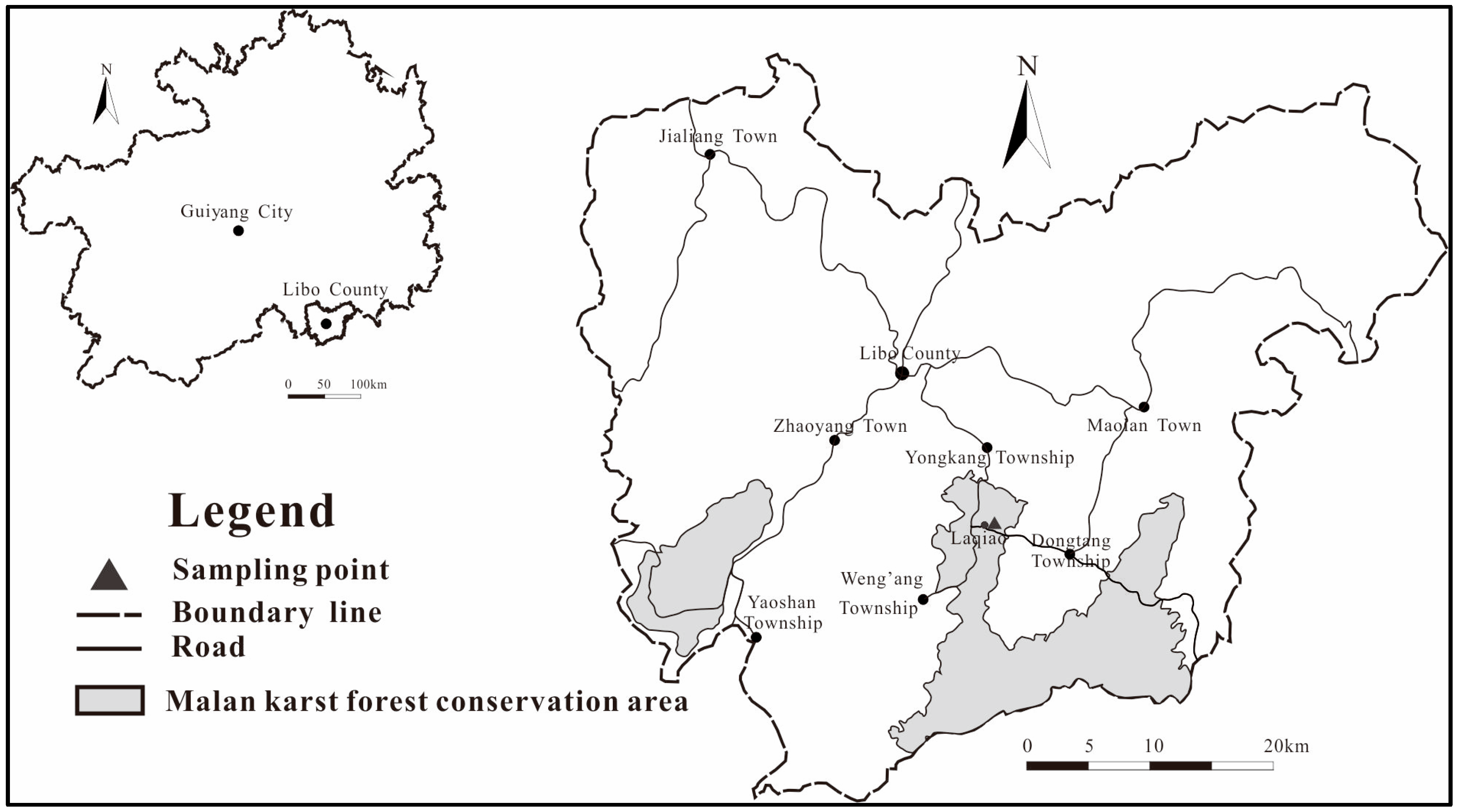
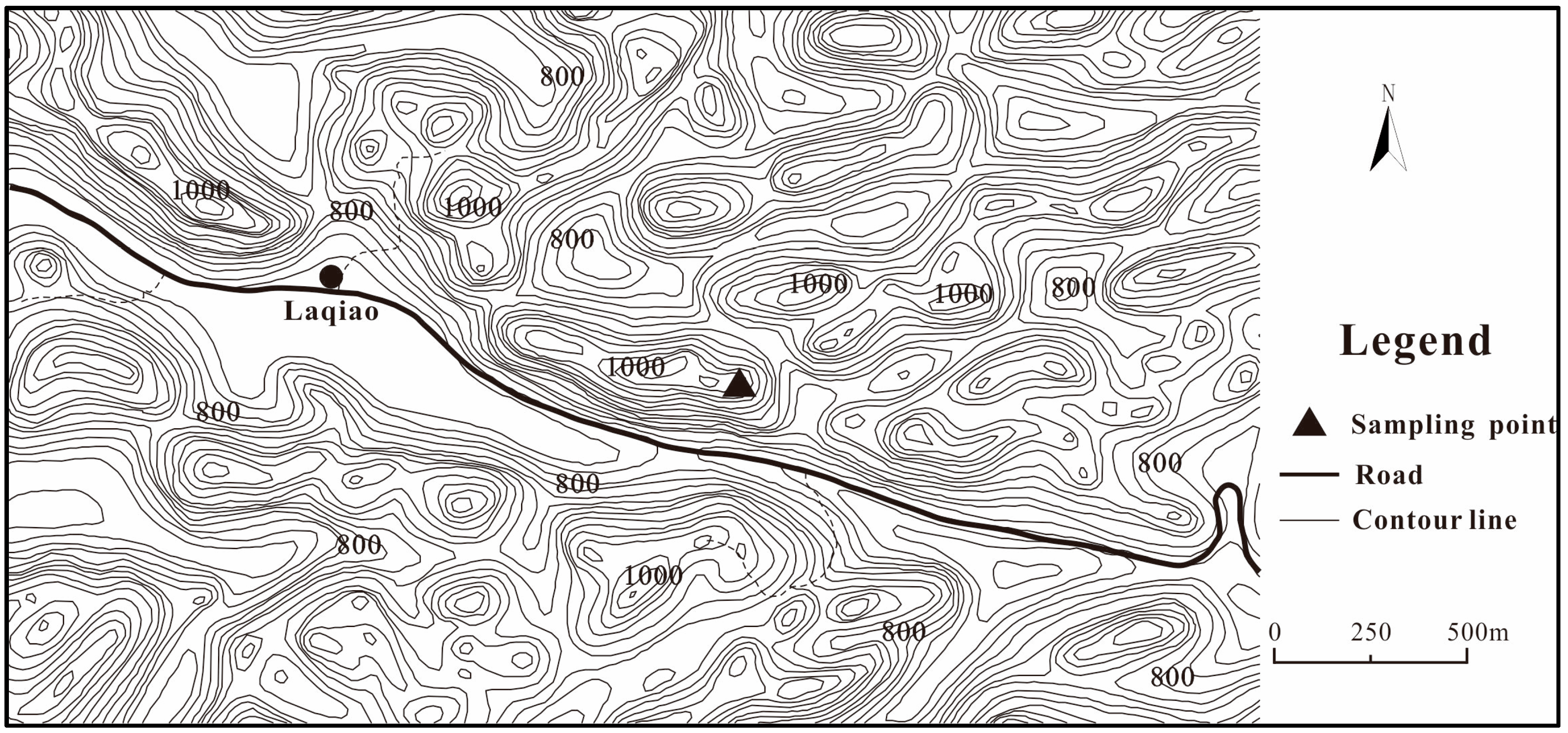
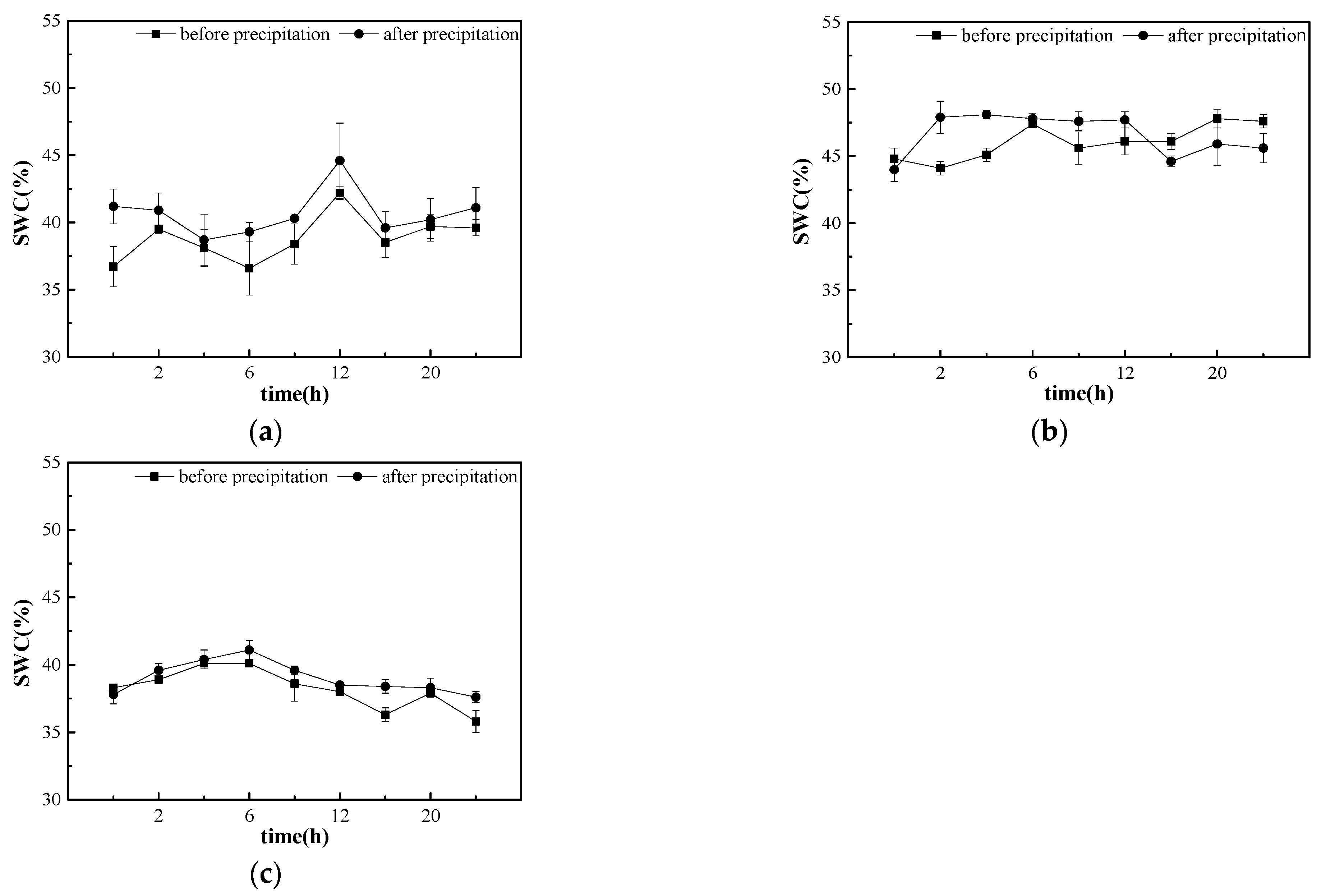
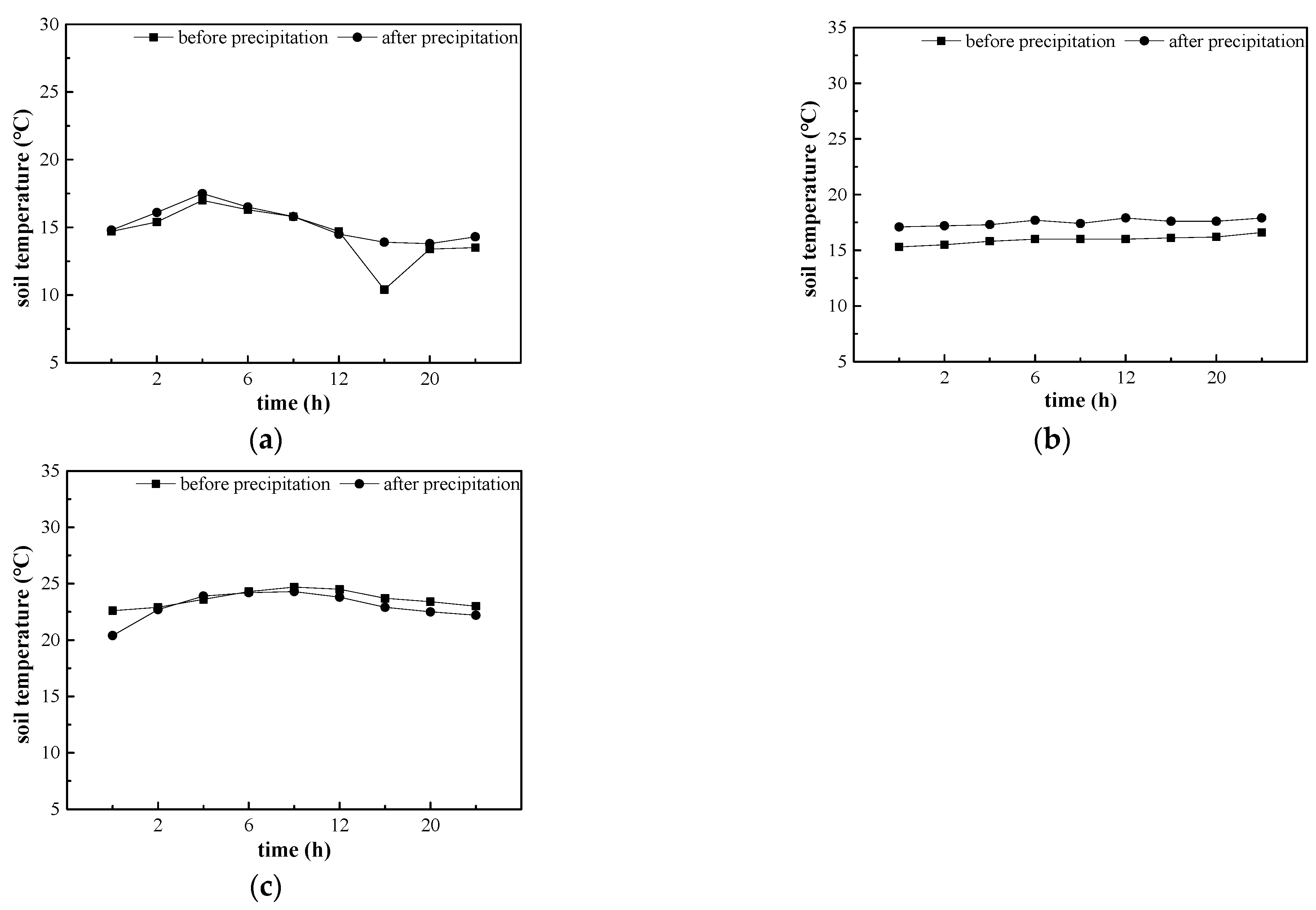

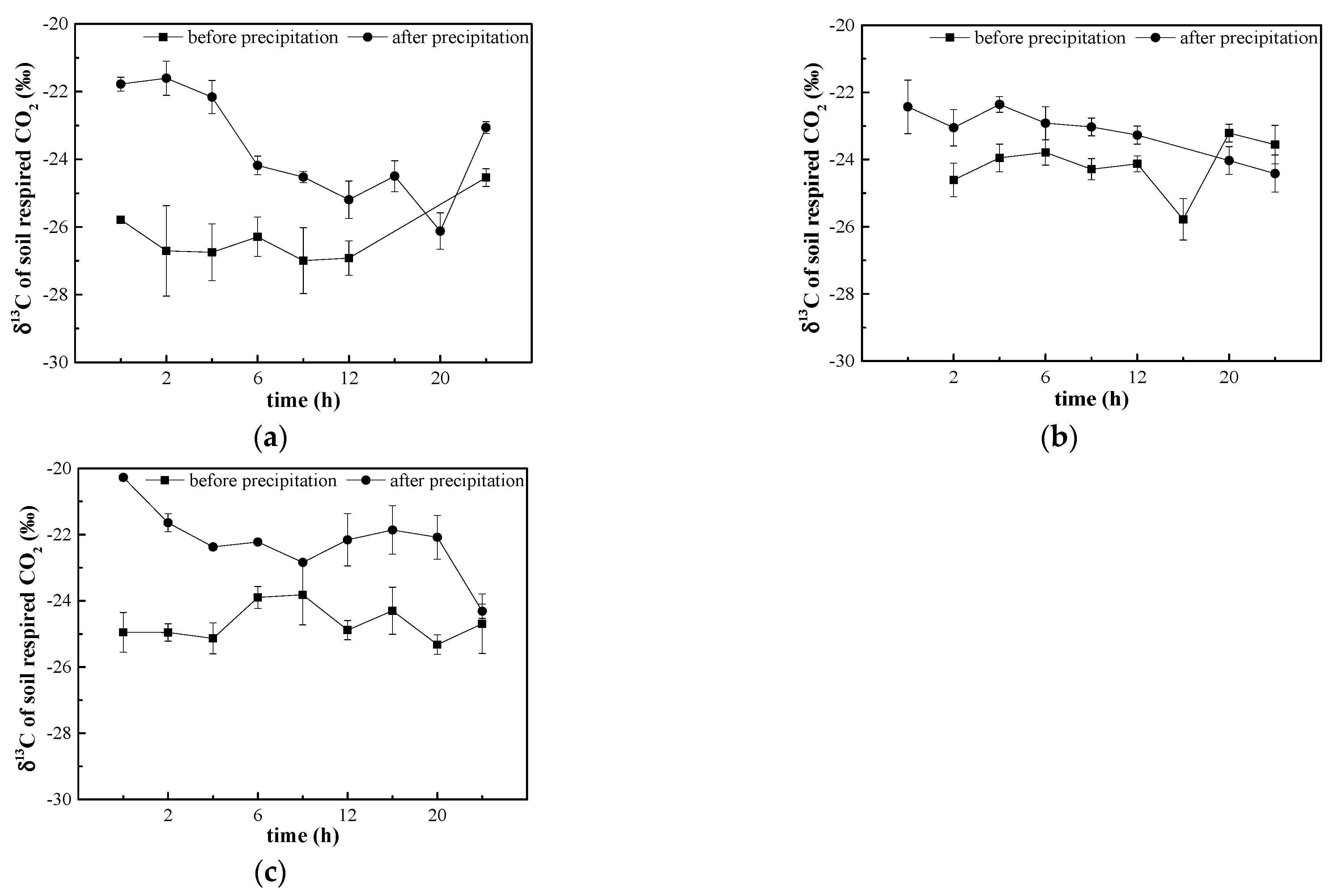
| pH | SOC (%) | N (%) | Clay (%) | Silt (%) | Sand (%) | |
|---|---|---|---|---|---|---|
| 0–10 cm | 7.94 | 7.35 | 0.60 | 17.3 | 53.7 | 29.0 |
| 10–20 cm | 7.53 | 7.56 | 0.76 | 11.6 | 67.6 | 20.7 |
| Rainfall Day | Duration | Amount of Rain |
|---|---|---|
| 14 November 2008 | 20 min | 8 mm |
| 30 April 2009 | 20 min | 25 mm |
| 6 June 2009 | 20 min | 25 mm |
| Time (h) | Before Simulated Rainfall | After Simulated Rainfall | ||||
|---|---|---|---|---|---|---|
| a | b | c | a | b | c | |
| 1 | 19.2 | 14.8 | 23.0 | 19.7 | 18.4 | 25.6 |
| 2 | 20.4 | 15.6 | 24.2 | 20.9 | 18.2 | 29.2 |
| 4 | 19.0 | 16.0 | 26.7 | 18.3 | 18.3 | 29.8 |
| 6 | 17.9 | 16.0 | 29.0 | 17.4 | 18.3 | 29.6 |
| 8 | 14.1 | 15.8 | 29.2 | 14.8 | 18.5 | 29.2 |
| 12 | 10.3 | 16.2 | 25.2 | 10.6 | 18.6 | 26.3 |
| 16 | 10.2 | 16.6 | 23.5 | 12.1 | 18.8 | 25.1 |
| 20 | 9.2 | 16.6 | 23.8 | 12.5 | 18.6 | 23.8 |
| 24 | 16.4 | 17.9 | 22.3 | 18.5 | 19.0 | 22.9 |
| CO2 | |
|---|---|
| Chromatographic column | Porapak Q (80/100 mesh; diameter: 3.15 mm; length: 3 m) |
| Carrier gas | High-purity N2 |
| Carrier gas flow rate (mL·min−1) | 20 |
| Column box temperature (°C) | 50 |
| Converter/temperature (°C) | Nickel converter/375 |
| Flame ionization detector/temperature (°C) | FID/250 |
| Air/H2 flow rate (mL·min−1) | 350/30 |
Disclaimer/Publisher’s Note: The statements, opinions and data contained in all publications are solely those of the individual author(s) and contributor(s) and not of MDPI and/or the editor(s). MDPI and/or the editor(s) disclaim responsibility for any injury to people or property resulting from any ideas, methods, instructions or products referred to in the content. |
© 2024 by the authors. Licensee MDPI, Basel, Switzerland. This article is an open access article distributed under the terms and conditions of the Creative Commons Attribution (CC BY) license (https://creativecommons.org/licenses/by/4.0/).
Share and Cite
Lv, W.; Liu, X.; Ding, H. Characteristics, Sources, and Mechanisms of Soil Respiration under Simulated Rainfall in a Native Karst Forest in Southwestern China. Forests 2024, 15, 945. https://doi.org/10.3390/f15060945
Lv W, Liu X, Ding H. Characteristics, Sources, and Mechanisms of Soil Respiration under Simulated Rainfall in a Native Karst Forest in Southwestern China. Forests. 2024; 15(6):945. https://doi.org/10.3390/f15060945
Chicago/Turabian StyleLv, Wenqiang, Xiuming Liu, and Hu Ding. 2024. "Characteristics, Sources, and Mechanisms of Soil Respiration under Simulated Rainfall in a Native Karst Forest in Southwestern China" Forests 15, no. 6: 945. https://doi.org/10.3390/f15060945





